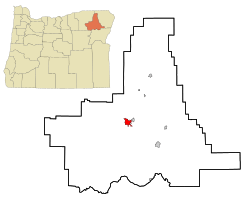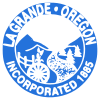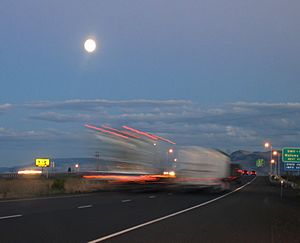La Grande, Oregon facts for kids
Quick facts for kids
La Grande, Oregon
|
||
|---|---|---|

Clockwise: Aerial view of the city; the Foley Building; the Granada theater; Carnegie Library; Catherine Creek; Eastern Oregon University Pierce Library
|
||
|
||
| Motto(s):
The Hub of Northeast Oregon
|
||

Location in Oregon
|
||
| Country | United States | |
| State | Oregon | |
| County | Union | |
| Incorporated | 1865 | |
| Area | ||
| • Total | 4.59 sq mi (11.89 km2) | |
| • Land | 4.58 sq mi (11.87 km2) | |
| • Water | 0.01 sq mi (0.03 km2) | |
| Elevation | 2,772 ft (845 m) | |
| Population
(2020)
|
||
| • Total | 13,026 | |
| • Density | 2,842.86/sq mi (1,097.61/km2) | |
| Time zone | UTC−8 (Pacific) | |
| • Summer (DST) | UTC−7 (Pacific) | |
| ZIP code |
97850
|
|
| Area code(s) | 458 and 541 | |
| FIPS code | 41-40350 | |
| GNIS feature ID | 2411568 | |
| Website | City Of La Grande Website | |
La Grande (/ləˈɡrænd/) is a city in Union County, Oregon, United States. It is the biggest city in Union County. In 2010, about 13,082 people lived there. The larger area around La Grande, called the metro area, has about 25,076 people. This makes it the 16th largest metro area in Oregon.
La Grande is special because it's in the Grande Ronde Valley. This valley is surrounded by mountains like the Blue Mountains and Elkhorn Mountains. The Eagle Cap Wilderness and Grande Ronde River are also nearby. These natural areas offer lots of wildlife and outdoor fun.
Long ago, La Grande was known for logging and farming. Today, it's a popular spot for outdoor sports. It's also a central place for nearby towns, offering shopping and entertainment. La Grande is known for its arts scene. You can visit the Liberty Theater downtown or see shows at the Elgin Opera House. La Grande is also a college town, home to Eastern Oregon University, with many students.
Contents
History of La Grande
La Grande was first called "Brownsville." But there was already a city with that name in Linn County. So, the name had to change. The city is in the Grande Ronde Valley. Its name, "La Grande," comes from an early French settler named Charles Dause. He used this phrase to describe how beautiful the area was. La Grande is also the main city, or county seat, of Union County. It is located east of the Blue Mountains.
Early Days in La Grande
The Oregon Trail passed through the Grande Ronde Valley for a long time. The first person to settle permanently in the La Grande area was Benjamin Brown in 1861. Soon after, the Leasey family and about 20 other people moved there. The settlement was first called Brown's Fort, Brown's Town, or Brownsville.
Since there was already a Brownsville in Linn County, a new name was needed when the post office opened in 1863. They chose "La Grande." This was a French phrase that Charles Dause used to describe the area's amazing beauty. Before the post office, William Currey would carry mail on horseback. He charged 50 cents a letter to go to and from the nearest post office in Walla Walla, Washington. La Grande officially became a city in 1865. Its streets and lots were planned out in 1868.
Growing Up in La Grande
La Grande grew very fast in the late 1860s and early 1870s. This was partly because of the many gold mines nearby. Also, the valley was great for farming. The first businesses were on C Avenue.
In 1884, the railroad arrived just east of "Old Town." This helped the city grow even more. A "New Town" started around Adams Avenue, built right next to the railroad tracks. By 1900, La Grande had a population of 2,992 people.
Eastern Oregon University in La Grande started in 1929. It was first called Eastern Oregon Normal School. It was a teachers college where people learned to become teachers.
Sweet History: The Sugar Factory
La Grande once had a factory that turned sugar beets into raw sugar. These sugar beets came from a nearby town called Nibley, Oregon. Both the factory and the town were owned by the Oregon Sugar Company. In 1899, the factory's superintendent, R. Doerstling, saw a Native American teepee made from old cloth filters from the factory.
Where La Grande Is Located
The city covers about 4.61 square miles (11.94 square kilometers). Most of this area is land, with a small part being water. La Grande is a main center in the valley. Mount Emily is a famous landmark in the Grande Ronde Valley. It stands tall over La Grande to the north. You often see Mount Emily on local organization logos. On the other side of the valley, Mount Harris is a similar landmark.
Weather in La Grande
La Grande has a climate with warm, dry summers and cold winters. This type of weather is called a warm-summer Mediterranean climate.
| Climate data for La Grande, Oregon (1991–2020 normals, extremes 1965–present) | |||||||||||||
|---|---|---|---|---|---|---|---|---|---|---|---|---|---|
| Month | Jan | Feb | Mar | Apr | May | Jun | Jul | Aug | Sep | Oct | Nov | Dec | Year |
| Record high °F (°C) | 61 (16) |
66 (19) |
79 (26) |
88 (31) |
95 (35) |
108 (42) |
108 (42) |
106 (41) |
103 (39) |
89 (32) |
71 (22) |
62 (17) |
108 (42) |
| Mean daily maximum °F (°C) | 39.3 (4.1) |
44.0 (6.7) |
51.6 (10.9) |
58.7 (14.8) |
67.8 (19.9) |
74.9 (23.8) |
86.2 (30.1) |
87.0 (30.6) |
77.3 (25.2) |
62.4 (16.9) |
47.7 (8.7) |
38.7 (3.7) |
61.3 (16.3) |
| Daily mean °F (°C) | 31.9 (−0.1) |
35.4 (1.9) |
41.1 (5.1) |
47.0 (8.3) |
55.2 (12.9) |
61.8 (16.6) |
70.3 (21.3) |
69.9 (21.1) |
61.0 (16.1) |
49.0 (9.4) |
38.8 (3.8) |
31.5 (−0.3) |
49.4 (9.7) |
| Mean daily minimum °F (°C) | 24.6 (−4.1) |
26.8 (−2.9) |
30.6 (−0.8) |
35.2 (1.8) |
42.5 (5.8) |
48.7 (9.3) |
54.5 (12.5) |
52.8 (11.6) |
44.8 (7.1) |
35.6 (2.0) |
30.0 (−1.1) |
24.4 (−4.2) |
37.5 (3.1) |
| Record low °F (°C) | −17 (−27) |
−10 (−23) |
9 (−13) |
16 (−9) |
24 (−4) |
22 (−6) |
32 (0) |
31 (−1) |
23 (−5) |
9 (−13) |
−14 (−26) |
−18 (−28) |
−18 (−28) |
| Average precipitation inches (mm) | 1.67 (42) |
1.23 (31) |
1.72 (44) |
1.83 (46) |
2.24 (57) |
1.37 (35) |
0.60 (15) |
0.67 (17) |
0.67 (17) |
1.58 (40) |
1.94 (49) |
1.88 (48) |
17.40 (442) |
| Average snowfall inches (cm) | 3.3 (8.4) |
1.0 (2.5) |
0.8 (2.0) |
0.1 (0.25) |
0.0 (0.0) |
0.0 (0.0) |
0.0 (0.0) |
0.0 (0.0) |
0.0 (0.0) |
0.0 (0.0) |
1.2 (3.0) |
3.0 (7.6) |
9.4 (24) |
| Average precipitation days (≥ 0.01 in) | 9.8 | 7.9 | 10.2 | 9.9 | 9.2 | 7.9 | 3.8 | 3.0 | 3.8 | 7.8 | 10.1 | 11.2 | 94.3 |
| Average snowy days (≥ 0.1 in) | 3.2 | 1.6 | 1.3 | 0.2 | 0.0 | 0.0 | 0.0 | 0.0 | 0.0 | 0.0 | 1.3 | 3.5 | 11.1 |
| Source: NOAA | |||||||||||||
Who Lives in La Grande?
| Historical population | |||
|---|---|---|---|
| Census | Pop. | %± | |
| 1870 | 240 | — | |
| 1880 | 400 | 66.7% | |
| 1890 | 2,583 | 545.8% | |
| 1900 | 2,991 | 15.8% | |
| 1910 | 4,843 | 61.9% | |
| 1920 | 6,913 | 42.7% | |
| 1930 | 8,050 | 16.4% | |
| 1940 | 7,747 | −3.8% | |
| 1950 | 8,635 | 11.5% | |
| 1960 | 9,014 | 4.4% | |
| 1970 | 9,645 | 7.0% | |
| 1980 | 11,354 | 17.7% | |
| 1990 | 11,766 | 3.6% | |
| 2000 | 12,327 | 4.8% | |
| 2010 | 13,082 | 6.1% | |
| 2020 | 13,026 | −0.4% | |
| source: | |||
In 2010, there were 13,082 people living in La Grande. There were 5,395 households, which are groups of people living together. About 3,073 of these were families.
Most people in La Grande (91.3%) were White. Other groups included African American (0.8%), Native American (1.4%), Asian (1.1%), and Pacific Islander (1.5%). About 4.6% of the people were Hispanic or Latino.
About 28.4% of households had children under 18 living with them. Many households (40.7%) were married couples. About 11.7% had a female head of the house with no husband. And 4.6% had a male head of the house with no wife. About 43.0% of households were not families.
The average age in the city was 32.8 years old. About 22.4% of residents were under 18. About 16% were between 18 and 24 years old. And 14.8% were 65 years or older. The city had slightly more females (51.9%) than males (48.1%).
Cool Places to See
La Grande has a special area called the La Grande Commercial Historic District. This district is listed on the National Register of Historic Places. This means it's an important historical area. It covers about 42.7 acres. The district is bordered by the railroad tracks, Spring Avenue, Greenwood Street, Cove Avenue, Washington Avenue, and Fourth Street.
Schools and Learning
The schools in La Grande are part of the La Grande School District. These schools include Central Elementary School, Island City Elementary, Greenwood Elementary School, and La Grande Middle School. The city also has La Grande High School. La Grande is also home to Eastern Oregon University, a college where students can earn degrees.
News and Entertainment
The Observer is the local daily newspaper in La Grande. You can also listen to several local radio stations. These include KLBM AM 1450 and FM stations like KUBQ FM 98.7, KWRL FM 102.3, KTVR FM 90.3, KCMB FM 104.7, and KRJT FM 105.9.
La Grande is considered part of the Portland television market. This is even though it's far from Portland. For example, the Spanish language TV channel Univision affiliate KUNP (channel 16) is licensed to La Grande. It is a sister station to Portland's ABC affiliate KATU (channel 2).
Getting Around La Grande
Roads and Highways
 Interstate 84 is the main highway that goes past La Grande. It connects La Grande to other nearby cities like Pendleton and Baker City. It also links to bigger cities like Portland, Boise, Idaho, and Seattle in Washington.
Interstate 84 is the main highway that goes past La Grande. It connects La Grande to other nearby cities like Pendleton and Baker City. It also links to bigger cities like Portland, Boise, Idaho, and Seattle in Washington. U.S. Route 30 is La Grande's main street. It is known as Adams Avenue.
U.S. Route 30 is La Grande's main street. It is known as Adams Avenue. Oregon Route 82 starts in La Grande. Its part in La Grande is called Island Avenue. This road leads to Island City, a suburb north of La Grande. OR 82 ends in Joseph, Oregon.
Oregon Route 82 starts in La Grande. Its part in La Grande is called Island Avenue. This road leads to Island City, a suburb north of La Grande. OR 82 ends in Joseph, Oregon. Oregon Route 237 starts in nearby Island City. It is the main road to Cove. It ends in North Powder and connects to Interstate 84 there.
Oregon Route 237 starts in nearby Island City. It is the main road to Cove. It ends in North Powder and connects to Interstate 84 there. Oregon Route 203 begins southeast of La Grande. It is near where Interstate 84 and U.S. Route 30 meet. This road is the main way to the town of Union. It ends a few miles north of Baker City.
Oregon Route 203 begins southeast of La Grande. It is near where Interstate 84 and U.S. Route 30 meet. This road is the main way to the town of Union. It ends a few miles north of Baker City.
Trains
La Grande is a stop for train crews on the Union Pacific Railroad. The railroad was first built through this area in 1884. Between 1977 and 1997, the city had a train station for Amtrak's Pioneer route. This train traveled between Chicago, Salt Lake City, Portland, and Seattle. The old station building from 1930 is still there. Union Pacific uses it as offices. La Grande is also where the Idaho Northern and Pacific Railroad's short line to Elgin begins.
Flying In
- La Grande/Union County Airport is the local airport for the city.
Famous People From La Grande
- Ray Baum, an Oregon state legislator and lawyer.
- Bucky Buckwalter, a former coach and executive for the National Basketball Association.
- William De Los Santos, a poet, screenwriter, and film director.
- Ron Gilbert, a computer game designer known for LucasArts adventure games.
- Steve House, a professional climber and mountain guide.
- John F. Nugent, a United States Senator from Idaho.
- Jack Ward Thomas, a senior research wildlife biologist and former Chief of the U.S. Forest Service.
- Agnes Vernon, a silent film actress.
- Paul Wheaton, a permaculture expert and software engineer.
See also
 In Spanish: La Grande (Oregón) para niños
In Spanish: La Grande (Oregón) para niños




